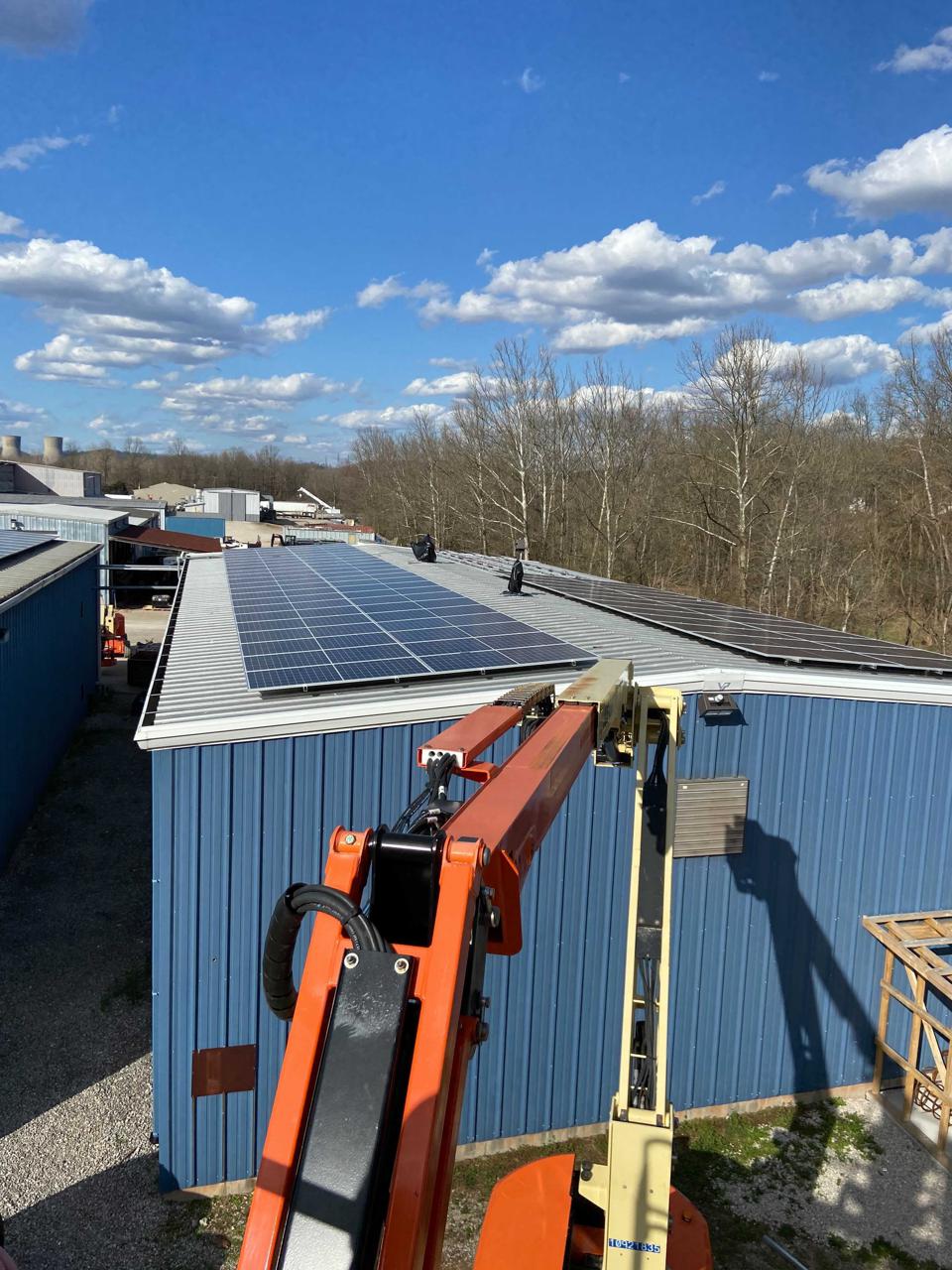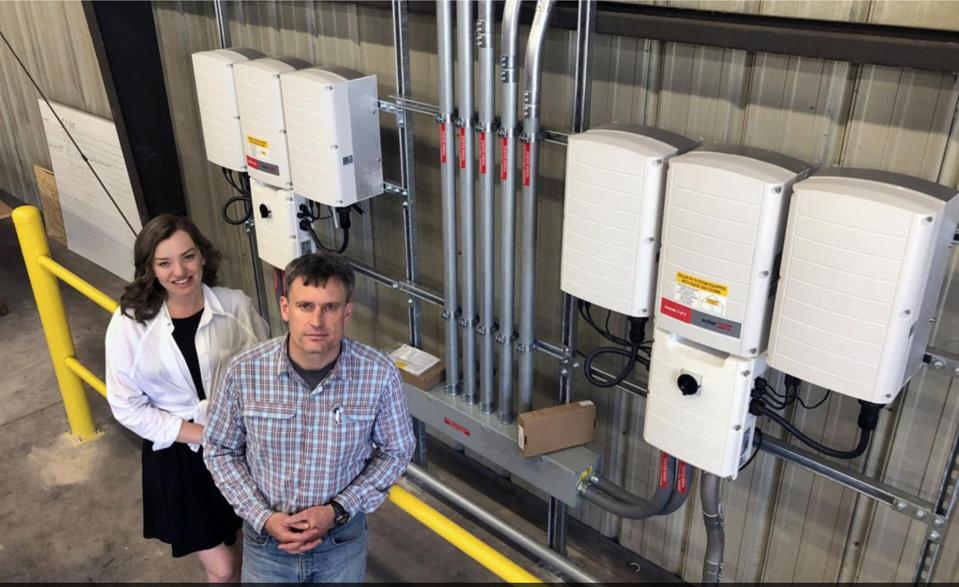The coal industry’s tight grip on West Virginia is loosening. That dam is cracking and is giving way to alternative fuels. Consider the case of Nitro Construction Services, which provides commercial and industrial businesses with electrical, mechanical, and technological services: the company is rooted in the coal industry but it is now ramping up its solar business.
 West Virginia is opening up to solar energy. REVOLT ENERGY
West Virginia is opening up to solar energy. REVOLT ENERGY
Corporations and constituents are putting pressure on state policymakers to pave the way for sustainable energy. And solar energy is now a cost-effective option. Indeed, national developers are buying up reclaimed coal mining sites intending to put large-scale solar farms in their place. They are anticipating that the Biden administration will enact a major infrastructure program — one that will provide incentives to those businesses that can help lift impoverished regions.
“I feel like we have been shot out of a cannon,” says Zach Drennen director of solar operations for Revolt Energy that is now a subsidiary of Nitro Construction Services. “West Virginia is just waking up to solar energy. We have been a coal-loving state but the economics of solar power are now undeniable: a commercial system will pay for itself in six years and a residential one in nine years. Even customers located in areas that are mountainous and cloudy will save money.”
In August 2019, Drennen and his partner, Keena Mullins, started Revolt Energy. They explained to this writer that the business had revenues of $1 million in year one and it will hit $2 million this year. It could double or triple in the next two years. There are now just 11 megawatts of solar in West Virginia, which ranks nationally almost dead last. A renewable portfolio standard that requires a set amount of green energy is necessary, says Mullins — something that at least half the states now have.
Nitro Construction Services and Revolt Energy see potential. The parent company installed 1,200 panels on its roof — a 487-kilowatt system. As the solar business blossoms, Revolt’s 10-person unit will add installers, electricians, procurement officers, salespeople, and software designers. It’s a union shop and one that pays solid wages with good benefits — a reason why the United Mine Workers Association said that they back President Biden’s green energy evolution.
“We are excited about this venture into the solar and renewable energy industry and see this as a market with a great opportunity for future growth,” Douglas Reynolds, president of Nitro Construction Services said. “With the current project at our Nitro facility, Revolt Energy is proving it can excel at large-scale commercial installations as well as residential.”
The Misperceptions
 Solar Panels are being placed on the facility of Nitro Construction Services in West Virginia. REVOLT ENERGY
Solar Panels are being placed on the facility of Nitro Construction Services in West Virginia. REVOLT ENERGY
Solar energy is nationwide — more than Florida, Texas, and California. While they make up a sizable share of the market, solar power is still thriving in Massachusetts, New Jersey, and New York. That’s because the panels have become so cheap and so efficient that they can save money for most homeowners and businesses: the panels can be installed at no upfront cost. They are financed with a 20-year low-interest loan — a monthly payment that Revolt Energy says is less than almost all electric bills.
That is made possible because of several federal programs that include an investment tax credit of 26%, accelerated depreciation, and a lucrative grant from the Rural Energy for America Program. Because businesses get more tax benefits, they can speed up their return on investment.
To be clear, Revolt Energy does not disconnect anyone from the grid: any excess power is wired back while any shortages are compensated by the utilities. It says that it uses a sophisticated software system that examines data over 50 years from the National Oceanic Atmospheric Administration. To that end, they can accurately gauge how many sun hours will hit the roof. That is then factored into the panels’ efficiency rate to determine the needs of a given homeowner or business.
Last year, West Virginia legislators passed bills so that the two biggest utilities — American Electric Power AEP +0.3% and FirstEnergy Corp. FE +0.3% — could install solar power in 50-megawatt increments. The legislature also passed a law allowing solar developers to enter into “power purchase agreements” with churches, schools, and municipalities — contracts that give them guaranteed sales at fixed prices.
Policymakers responded favorably to testimony from economic developers who said that prospective companies were demanding more access to renewable energy. The strategy is working: An EDF Renewables unit and Raleigh Solar applied late last year to build a 92.5 megawatt facility and a 90-megawatt project, respectively.
“The coal lobby came out against the power purchase agreement provisions and the Republican legislature still passed it,” says Revolt’s co-founder Keena Mullins. “The United Mine Workers Association is now supporting renewable energy development. Appalachian citizens who have benefited from coal understand that this industry is in decline. They want new jobs to move into. And it speaks volumes that the coal lobby has come out against the passage of bills to allow for more renewables but the actual workforce that makes up the coal industry is in favor of those laws.”
The Lord Giveth
 Keena Mullins and Zach Drennen, co-founders of Revolt Energy that is now part of Nitro Construction Services pose at solar site in West Virginia. BOB SAUNDERS, OF THE DAILY MAIL WV
Keena Mullins and Zach Drennen, co-founders of Revolt Energy that is now part of Nitro Construction Services pose at solar site in West Virginia. BOB SAUNDERS, OF THE DAILY MAIL WV
According to the U.S. Energy Information Administration, natural gas comprises 36% of the electric generation portfolio. Wind and solar make up 10%. Nuclear energy is 20%. And coal has fallen to its lowest level in decades, now at 19%. Solar, though, has the greatest potential, it says. Meantime, the Solar Foundation says that the industry employs 231,000 people in the United States. That’s compared to about 52,000 for the coal sector, says Statista.
Most mining jobs are now tied to exports — metallurgical coal that is used to make steel and sent to Asia. But the United Mine Workers Association President Cecil Roberts notes that coal miners make about $100,000 a year while solar panel installers make $20 an hour: miners would need two of those solar jobs to compensate them for one coal job. Nevertheless, he admits that coal production leads to global warming and black lung disease.
More to the point, one industry is growing while the other is dying. It’s no longer 1950. It’s 2021 and the industrial revolution has given way to the digital age and the New Energy Economy. Having a reliable job in the renewable energy field is far superior to having no job security at all. With that, President Biden’s vision is to get to 100% green energy by 2035 and to net-zero by 2050, which will create a global clean energy market worth $23 trillion. And his American Jobs Plan would pay for and train workers to run wind and solar projects.
The possibilities could reap rewards for West Virginia. Developers smell opportunity and are snatching up old mine sites. They are envisioning utility-scale solar farms that have access to transmission lines so that they can supply East coast markets. Going green is also an economic development tool that empowers the state to attract enterprises that are trying to brand themselves as climate-friendly.
“Once the coal is gone from a mountaintop removal site, the operators shut it down and move on,” says Revolt’s Mullens. “The land and its people are left devastated. West Virginia regulators know that the coal companies do not have the money to clean up abandoned mine sites. Coal is more of a liability than a benefit. As a result, there is public pressure to change. The market is taking over at this point.”
When Revolt Energy constructs a solar array, she adds that it does business with local companies — from fence-builders to equipment suppliers to solar installers. If its solar operations continue to expand, the whole supply chain will grow with it. Thus far, it is buying its solar panels from such brand names as Renewable Energy Corp., SolarEdge, and Enphase Energy ENPH +4.5%.
Job losses tied to coal’s demise will not be offset by building more Dollar Stores or call centers. Modern and sustainable industries can provide long-term and well-paid positions. Enter solar energy, which is now breaking into coal country. The Nitro Construction Company is proof-positive — a company that is grounded in the old economy but one that is waking up to today’s reality.